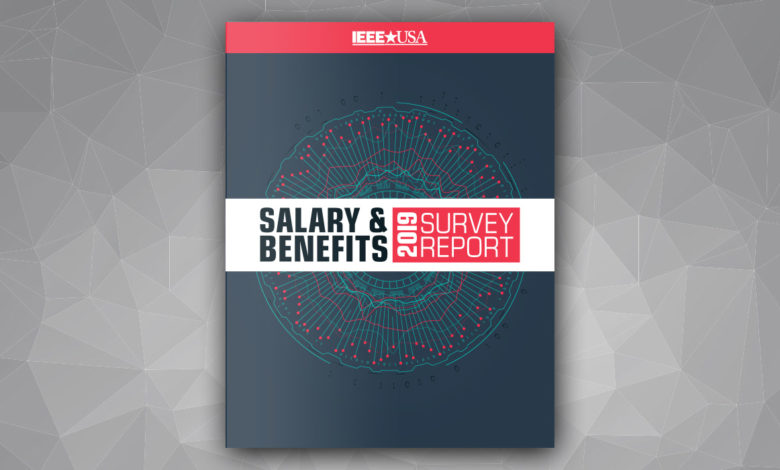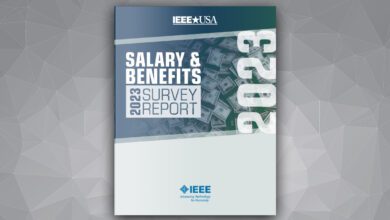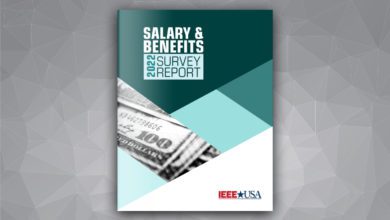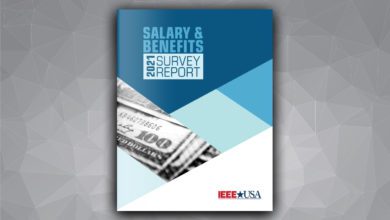
The latest results from the engineering world’s largest salary survey demonstrate a troublesome reality: For many, the profession is a fine way to make a living, but in several notable areas, such as salary parity for women and minority groups, there is plenty of room for improvement.
According to IEEE-USA’s 2019 Salary & Benefits Survey, conducted this past spring among U.S. IEEE members, salaries are continuing to rise. For members working full time in their primary area of technical competency (PATC), median pre-tax income in 2018 from all sources was $150,000, up from $145,000 in 2017. After excluding overtime pay, profit sharing and other supplemental earnings, median pre-tax income was $145,000, up from $138,800 in 2017.
But here’s the other side of the coin: women’s income continues to significantly lag behind men’s. Even when experience is factored in, the difference in median primary income between the genders, among those working fulltime in their PATC, is $19,000. While this is $1,000 less than last year, it’s still substantial.
In addition, although the salary gap between Caucasians and African-Americans in 2018 decreased by $3,750, African-Americans still earned $20,500 less than their White counterparts.
While other engineering salary reports are available, the IEEE-USA survey is possibly the most highly regarded, because of its longevity (this year marks the 32nd) and the large volume of responses. The study has been conducted most years since 1972. This year, 8,883 IEEE members participated, including 6,739 employed full time in their primary area of technical competence — the most relevant group from both employer and employee viewpoints.
The IEEE-USA Salary & Benefits Survey is comprehensive. It includes differences in each respondent’s income, technology sector, level of responsibility, age, education, gender, ethnic background, geographic location, and much more. Specific questions are included for the roughly 10 percent of U.S. members who are academics. Members who indicate that at least half of their earned income is from fee-based consulting are not included; they are queried for the IEEE-USA Consultants Fee Survey.
2019 Major Findings
According to the 2019 survey, the typical respondent is a male about 50 years old, with an advanced degree and about 23 years of professional experience, He is at the fifth or sixth of nine possible levels of professional responsibility, supervising a handful of others, both professionals and support staff.
The general Mobile Technology and Communications Technology PATCs continue to yield the highest earnings. Engineers working with smartphones and watches enjoyed a median salary of $215,771 last year. Those working with artificial intelligence and machine learning earned a median $185,000.
Continuing the trend of the past few years, Industrial Engineering and Energy & Power Engineering remain the lowest of PATC median incomes, at $132,000 and $130,000, respectively.
An engineer’s employment sector is significant in determining median income; those working in defense-related private industry earned the top median income ($155,994); closely followed by private industry, excluding defense or utilities ($155,000). On average, utilities employed those earning the least ($129,000), then educational institutions ($115,470) and state/local government ($104,000).
In a trend that began a decade ago, most members work for large organizations: 29.3% are employed by enterprises with more than 10,000 employees; and another 35.9% work for employers with 501 to 10,000 employees. Private, non-defense companies employ more than half (51%) of workforce members. When defense-related firms are included, the private-industry share rises to nearly two-thirds of members in the workforce (62.8%).
Not surprising, management jobs still yield the highest median primary income, at $191,074 in income from primary sources, while technical management earned a median $173,022.
Areas of Concern
Constituting only 8.5% of all members working full time in their PATCs, women continue to lag substantially behind men in primary income — even when experience is a factor. The overall difference in 2018 was $19,000 — $1,000 less than the previous year — but still huge. The gap starts out fairly small, but increases quickly with years of experience.
The salary disparity that continues between Caucasians and African-Americans is only slightly better than the median salary differences between Caucasians and Hispanics — $3,400. Median salaries for Asian/Pacific Islanders — who comprise the largest minority group (12.2%) of those surveyed — were only $2,250 less than those for Caucasians.
Members in Academe
Because the nature of employment in higher education is so different from industry and other types of organizations, specific survey questions help to profile this small but vital category of U.S. members. In the 2019 report, about one in ten respondents (11.1%) indicated their primary employer is a degree-granting institution. Of these respondents, 54.5% are on a nine- or 10-month contract, 32.5% on an 11- or 12-month contract, and 13% have some other arrangement. Better than one-third of this group (33.9%) are full professors, and another 16.8% are associate professors or assistant professors (15.2%). Most (76.2%) work at public or private institutions that grant doctoral degrees.
Geography Matters
Where an engineer lives and works continues to significantly affect earnings. The 2019 study reports median incomes according to both the six U.S. IEEE regions and the nine U.S. Census Bureau divisions. In terms of IEEE regions, those in Region 6 (West) fare substantially better than those in Region 4 (Central), with a gap of $32,000. Census divisions show a similar pattern, with those in the Pacific states (Alaska, Hawaii, Washington, Oregon, California) faring more than $40,000 a year better than those in the East North Central states (Wisconsin, Illinois, Michigan, Indiana, Ohio). However, the report points out that living costs in the West are substantially higher than elsewhere.
The top states for 2018 median income are California, District of Columbia and Massachusetts — each is at least $158,000. The bottom states are Montana, Arkansas, North Dakota and Iowa, at $114,000 or less. Because of high participation levels in the survey, compensation statistics can be meaningfully calculated for 60 U.S. metropolitan areas. Median primary income is highest in San Jose ($200,000), San Francisco ($192,269) and Los Angeles ($178,588). Cities where compensation is lowest include St. Louis, Columbus, Birmingham, Kansas City and Nashville — all at less than $116,000.
Benefits and Job Satisfaction
U.S. IEEE members who work full time are offered a broad array of benefits, although some shifts have taken place in the three main benefits categories: pension and retirement; health and insurance; and miscellaneous, which includes flexible working hours and professional association membership fees.
In the 2001 survey, companies offered more than half of full-time workers (55%) “Defined Benefit” pension retirement plans — promising employees a certain amount, if they meet the plan terms, such as a minimum number of years of service. Keeping with the societal trend, that percentage has dropped to 32% in 2019. Salary Reduction plans — so-called “Defined Contribution” plans — have remained flat since 2001, at 91.1% in the current survey.
Twenty-two percent of employers offer profit sharing plans, down from roughly 38% in 2003. Employee stock ownership plans (ESOP) are also down, from 40% then to 23% now.
Virtually all employers offer full-time workers extensive health benefits. More than nine in 10 are offered basic health and dental insurance, for both themselves and their dependents. Ninety percent are offered prescription drug coverage, and 93.7% are offered coverage for eyeglasses, lenses and exams.
In results similar to those of recent years, 84.3% of full-time workers are offered flexible working hours, and 54.3% are offered professional association membership fees. Paid maternity or paternity leave has increased from 55.5% in 2016 to 66% in 2019. Almost two out of three workers (64.2%) are now offered telework, up from 61.5% last year.
The complete IEEE-USA Salary & Benefits Survey is available from the IEEE-USA shop. The member price is $125; non-members pay $225.
Helen Horwitz is an award-winning freelance writer who lives in Albuquerque, N.M. She was with IEEE from 1991 through 2011, the first nine as staff director, IEEE Corporate Communications.







There should be an executive summary available for this report for free to IEEE members.
Most engineers would be interested in their work region not the whole United States.
The complete IEEE-USA Salary & Benefits Survey is available from the IEEE-USA shop. The member price is $125; non-members pay $225.
Ron Ogan
IEEELSM